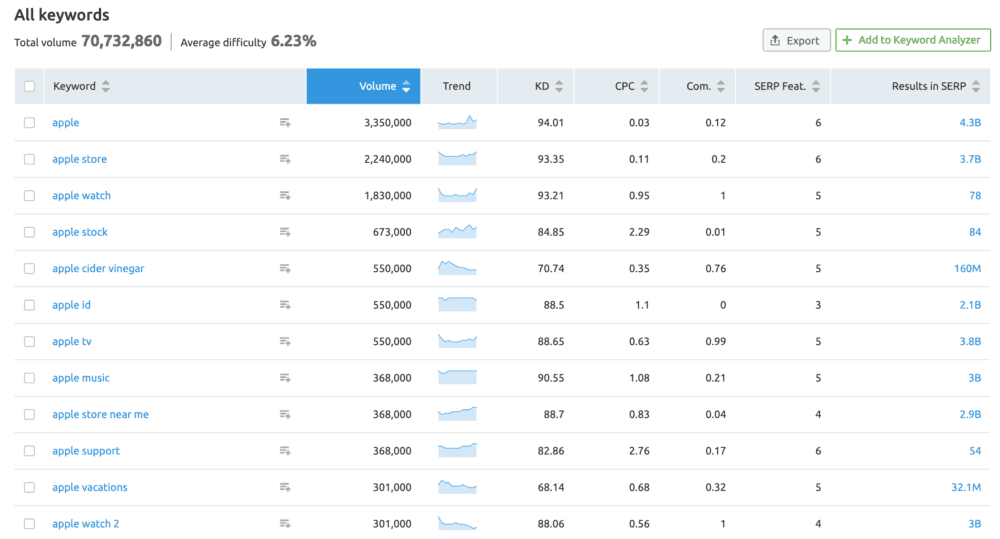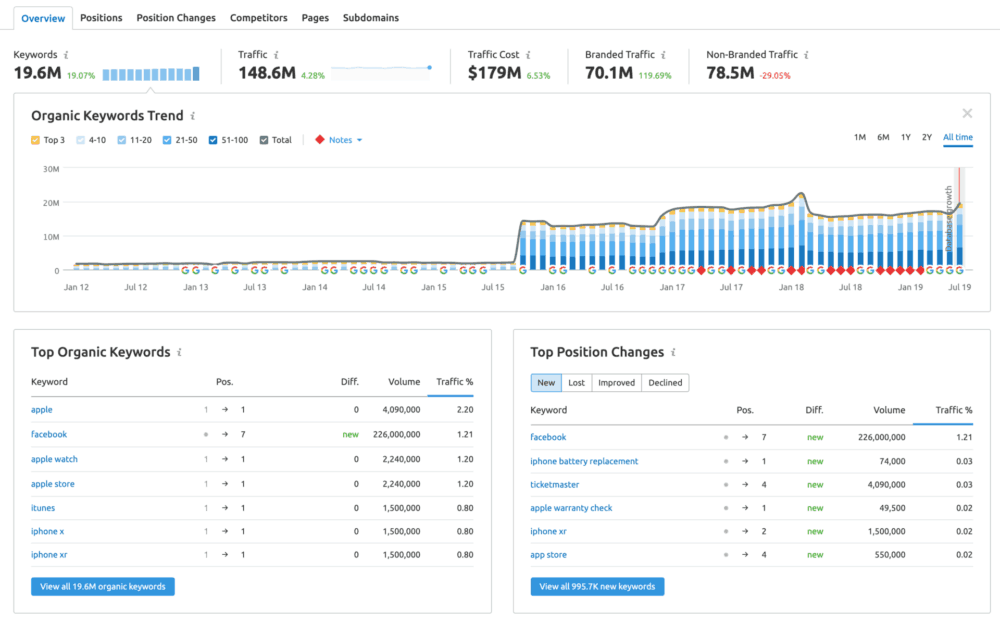SEMrush is one of the world’s #1 SEO tools, and in this guide we’ll show you how to use SEMrush to dominate your competitors…
#1) Find ALL The Keywords You’ll Ever Need (Keyword Magic)
At the heart of any good blog or website is a solid keyword research strategy. Without it, you’re simply guessing. And guesswork and SEO are NOT a good combination. SEMrush has one of the best keyword finders I have ever used. It’s called Keyword Magic.

Inside this section of the tool, you can find new, hugely lucrative keywords and keyword phrases. All you have to do is type in a query, it can be a single phrase, and start building out your keyword strategy from there. And the tool is idiot-proof, making it ideal for newbies to SEO.

Once you enter your desired keyword or subject matter, SEMrush’s Keyword Magic tool will pull in ALL the data you need to get started, including volume, keyword difficulty (KD), competition (Com.), the number of current results, and SERP features.

SEMrush’s Keyword Magic tool can then break the phrase down into the following types of query:
- Broad Match – Any Variation of Your Keyword In Any Order
- Phrase Match – Exact Keyword Phrase In Various Orders
- Exact Match – Exact Keyword or Phrase
- Related – A List of Keywords That Are Similar To Your Keyword
From here, you can then make a decision based on all the criteria. I like to go after keywords with high volume and low keyword difficulty (KD). Doing this will yield the fastest and most lucrative results when developing new content.
#2) Check What Your Competition is Ranking For (AKA Their Top Content)
If you run a blog or a website for a living, you NEED to know what your competition is doing. If you don’t, you’re simply leaving money (and rankings) on the table. With SEMrush, spying on your competitors has never been easier – you’re just a click away from all the details you’ll ever need about your competitors in your niche.
The way I like to access data about my competitors is inside Main Organic Competitors, which you can find inside Domain Overview. Inside Domain Overview, you’ll get a ton of stats about your site (or your competitors) as well as an overview of its (their) main competition.

From here, you can drill down into each of the competitor sites and find out what they are ranking for, how they are ranking, and what their top performing keywords are. You can then perform a keyword gap analysis between you and them to find gaps in your content strategy.
Once you know where the gaps are, you can set about filling in the holes and start catching them up. This tool is superb for on-the-fly data and, in my opinion, is vastly superior to Ahrefs’ solution which often pulls in false and/or inaccurate data. No other tool offers such robust data and settings as SEMrush. In this context, it is the #1 option by a considerable margin.
#3) Get A Complete Overview of Social Campaigns (And Then Automate Them)
Inside SEMrush, you have the ability to grant it access to all your social media channels – Facebook, Twitter, Instagram. For here, you can view interactions with your posts, when the best time to post your content is (based on when most of your followers are online, and even automate post schedules weeks and months in advance.
You can even install a Chrome add-on called SEMrush Social Media Poster that will let you post images and articles from inside your browser – all you have to do is click on the icon (it’s usually housed inside images displayed in the body copy of posts). This feature and the Chrome add-on are brilliant for getting a better handle on your social media.
Bottomline: if you’re time-poor, but need to get a handle on your social media output, SEMrush has exactly the tools you need to automate, analyze, and improve your social media performance.
#4) It Shows You How To Build A Perfectly Optimized SEO Post
For SEO newbies, SEMrush’s SEO Content Template is an absolute GODSEND. How it works is simple: you enter the keyword or phrase your post is going to be about, hit create template, and SEMrush shows you exactly how to structure your post for maximum traction inside Google.

How does SEMrush’s SEO Content Template work? Simple:
- Enter Keyword/Phrase + Hit Create SEO Template
- SEMrush Then Analyzes The Top 10 Results From Page One of Google
- Third, The Template is Laid Out With Everything You Need To Follow
Inside the SEO Content Template guide you will get a list of the top 10 ranking sites, semantic keywords to include in your copy, the number of backlinks you will require to rank, readability scores, and the exact length your post needs to be.
#5) Monitor Thousands of Your Keywords (Position Tracking)
Google Analytics is great for tracking your site’s progress in real-time and on a day-to-day basis. It’s also brilliant for historic data mining, but sometimes you just want to see what’s going on with ALL your ranked keywords in one place. And this is where SEMush’s Position Tracking comes into play.
You can enter thousands of keywords, get these from Google Search Console, and monitor how they’re performing on a daily basis. If they’re up, great. Nothing to do. But if they’re down, you need to find out why. And this tool is the easiest way to bulk manage all of your rankings in one place.
You get visibility scores (done in a percentage), rankings distribution (what page you’re on in Google), devices and locations, and whether or not you are included inside Google’s featured snippets. It will even tell you your site’s average position, based on your entire keyword portfolio.
And if that wasn’t enough, you can then add a competitor’s domain into the mix and see how you compare to them on a micro and macro level. The level of detail and actionable information contained inside Position Tracking is phenomenal. No other tool, not even Google Search Console, offers such comprehensive tools for monitoring and analyzing your ranked keywords.
#6) Find Out Why Other Sites Are Out-Ranking You (Keyword Gaps)
I mentioned this earlier, but as one of SEMrush’s #1 tools it certainly warrants a more detailed explanation. Keyword Gaps are the reason why your competition are doing better you than; they have more keywords ranked in Google and, therefore, have more visibility and more traffic.
Using the Keyword Gaps tool, you can quickly compare up to four domains to your own domain and find out how and where they’re beating you with respect to keywords. Once you’ve done this, you can export the data to a CSV file or a spreadsheet, and start working your way through the gaps, filling in the holes. And a few months down the line, with a bit of elbow-grease, those gaps will have shrunk and your site will be more competitive in Google, meaning more traffic and more money.
#7) SEMrush Has The Ultimate Link-Building Tool
SEMrush prides itself on being one of the best tools for backlink analysis and acquisition. In this respect, it is very much on a par with Ahrefs – a very good tool for backlink information. But what I prefer about SEMrush’s way of doing things is ALL the features it places at your disposal.
Inside the Link Building section, you will find several options:
- Backlink Analytics
- Backlinks Audit
- Link Building Tool
- Bulk Analysis
The most useful for those looking to increase the number of backlinks pointing to their website is Link Building Tool. Why? Simple: it gives you a list of prospects that will almost certainly link to your site should you choose to reach out to them.
You can then use this tool to isolate potential sites for backlinks. Inside the data feed of prospects, which is based on your specific niche, you will find data about the sites’ domain authority, domain relevance, and domain health – you want all of them to be nice and high.
And if you don’t want to manually email these people, you can add a mailbox to SEMrush, set an automated message up, and let SEMrush email prospects around the clock, earning you potentially thousands of new backlinks for your site.
SEMrush Pricing & Why You Should Probably Invest…

The above points only really scratch the surface of what you can do with SEMrush. As a tool for improving your site’s SEO and overall rankings in Google, nothing else comes close to SEMrush – it is pretty much in a league of its own. That is why it is used by the biggest media and publishing entities on the planet.
SEMrush offer a variety of packages; personally, I use the $99 a month one, as it gives me everything I need – and a whole lot more. I know $99 a month seems like a lot of money, but you can’t look at it like an outgoing; SEMrush is an investment in the growth of your site. With it, you will find lucrative content gaps, holes in your SEO, and new keywords that you can use to generate thousands of dollars in additional revenue.
Bottomline: if you’re serious about your website, blog, or e-commerce store, and you’re not using SEMrush… you are basically leaving money, keywords, and rankings on the table. In this day and age, you simply cannot afford to not be using a tool like SEMrush.